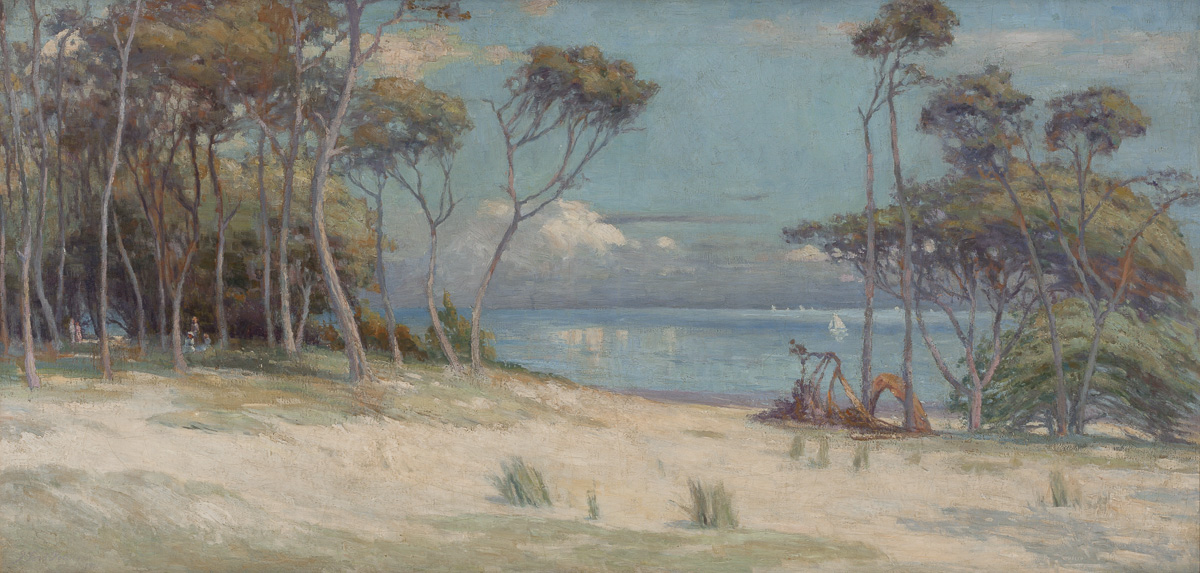Rickett’s Point
John Ford Paterson

Details
- Artist
- John Ford Paterson
- Title
- Rickett’s Point
- Year
- 1908
- Medium
- oil on canvas
- Size
- 71 x 144 cm
- Details
signed lower left: J. Ford Paterson 1908
- Stock Number
- 214061
Provenance
the artist
by descent to the artist's great-niece
Kathie Robb Fine Art, Sydney
David R.C. Waterhouse, Sydney
Fine Australian and International Paintings, Sotheby’s Australia, Melbourne, 26 November 2001, lot 42
Richard A. Young, Queensland (founder of Koala Koaches, Qld)
by descent
corporate collection, Melbourne
Exhibited
on loan, McClelland Gallery, Langwarrin, 1980-85
Golden Summers: The Heidelberg School and Beyond, National Gallery of Victoria, Melbourne 30 Oct 1985 - 27 Jan 1986v
Further Information
Ricketts Point on Port Phillip Bay, as a favourite painting ground for Australian impressionist artists of the 1880s, holds a special place in the annals of Australian art, specifically, Australian nationalism. In the summer of 1886–1887, Tom Roberts, Frederick McCubbin and Louis Abrahams, had rented a house at Mentone, where the artists were drawn to the beauty of the nearby Beaumaris cliffs and the shoreline, including Ricketts Point.
Roberts, McCubbin, Streeton and later Charles Conder, all painted memorable pictures of the shores of Beaumaris and Mentone, capturing the light, beauty and interest of the shore. Seminal paintings include Robert’s The Sunny South, 1887 at Ricketts Point and his iconic Mentone; Frederick McCubbin’s best known bayside painting Moyes Bay Beaumaris, 1887, while Streeton’s lively painting Mentone 1887 depicts a young girl standing on a wave swept shore, which appears to be Ricketts Point. Charles Conder, the designer of the cover for the 9 by 5 Impressions Exhibition, painted the evocative Rickett’s Point in 1890.
Here John Ford Paterson, who was popular and much admired by this younger generation of painters, has evoked an ethereal almost art nouveau quality in his Ricketts Point. The water sparkles; gently swaying ti-trees frame the composition with their decorative curving silhouettes. The colourful picknicking figures seem almost an intrinsic part of this sunlit bayside scene. In its style and imagery, Ricketts Point is unquestionably, an iconic beach scene, a popular theme in Australian painting from the late 1880s to early 1900s – the whiteness of the coastal landscape, the blueness of the sea, the yachts, and the impressionistically depicted picnickers.
Arguably Paterson's masterwork, Ricketts Point, was included in the National Gallery of Victoria’s ground-breaking Golden Summers exhibition.
The Scottish-born Paterson family were important advocates in interior design in Melbourne, coming to the fore at the time of ‘Marvellous Melbourne’. John Ford returned to Scotland to continue his art studies, returning to Melbourne in 1884 having been influenced by the decorative and plein-airism of the Glasgow School.
